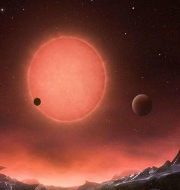Scientists discover smallest star known in the universe
Scientists from University of Cambridge, UK have discovered the smallest star in the universe. It has been named as EBLM J0555-57Ab.
The star was identified by SuperWASP, a planet-finding experiment run by several universities. It was detected when it passed in front of its larger parent star, forming an eclipsing stellar binary system.
Key Facts
EBLM J0555-57Ab is located about 600 light years away. It is slightly larger than Saturn in size and may possibly have Earth-sized planets with liquid water in its orbit. It is likely as small as stars can possibly become, as it has just enough mass to enable the fusion of hydrogen nuclei into helium at its centre .
The gravitational pull at EBLM J0555-57A’s stellar surface is about 300 times stronger than on Earth. It is likely colder than many of the gas giant exo-planets that have so far been identified. The discovery of EBLM J0555-57A also makes the best possible candidate for detecting Earth-sized planets which can have liquid water on their surfaces, such as TRAPPIST-1, an ultracool dwarf surrounded by seven temperate Earth-sized worlds.
About SuperWASP
SuperWASP is the UK’s leading extra-solar planet detection programme. It is run by a consortium of eight academic institutions. It consists of two robotic observatories that operate continuously all year around, to cover both hemispheres of the sky.
The first robotic observatory, SuperWASP-North is located on La Palma Island (in Atlantic Ocean) amongst the Isaac Newton Group of telescopes (ING). The second observatory, SuperWASP-South is located at the site of the South African Astronomical Observatory (SAAO), Sutherland, South Africa.
The observatories each consist of eight wide-angle cameras that simultaneously monitor the sky for planetary transit events. These cameras can monitor millions of stars simultaneously to detect the rare transit events.
Month: Current Affairs - July, 2017
2 Comments
Leave a Reply
You must be logged in to post a comment.



kirparam
July 13, 2017 at 9:55 pmVery nice discovery
kirparam
July 13, 2017 at 9:55 pmVery nice discovery